Job Market Stats & Trends 2017 –What’s the Next Best Thing to Get Into?
Last year the White House Reported that U.S. Businesses had added more jobs in 2014 & 2015 (2.4 million) than at any time since the 1990’s. With 14 million jobs added in the last six years. This is brilliant news for the job seeker.
“The United States of America, right now, has the strongest, most durable economy in the world.” – White House 2016
So who’s hiring?
In January the Bureau of Labor Statistics released their statistics on the job market in the U.S. Some findings included increases in hiring over the year in the retail (229,000), construction (170,000) and financial (15,000 per month) sectors. In January 2017 three industries made robust additions to their workforce –clothing/clothing accessories (+18,000), electronics/appliance stores (+8,000) and furniture/furnishing stores (+6,000). It looks like the job market is on the up and up.
The Future’s So Bright

Other interesting stats indicate that 5% more graduates from the class of 2016 will find employment according to the National Association of Colleges and Employers. Currently, the unemployment rate for people over 25 that have a bachelor’s degree (or higher) is sitting at 2.4 %. If you majored in the fields of business, engineering, accounting or computer science you’re in luck, they are the in-demand jobs where unemployment is at its lowest. If you made the software developer career choice –well done. The unemployment rate is very low at around 1.8 % and you get lovely big salaries and a healthy job growth to look forward to in the future. Some more good news for graduate hires is that employers are planning to raise their starting salaries by 3.2% this year.
“Optimism is at an all-time high,” said David Smith, a senior managing director at Accenture Strategy.
Where Are People Hiring in the U.S.?

Basically, the West and East coast take the lead in job creation. California created 464,200 jobs. The highest increase in jobs for a metropolitan area was in NYC (154,400). In second place was Los Angeles metro area with 135,000 jobs created and in third place was Texas with 98,900 new jobs. Unemployment rates dropped in 47 states. Many of these jobs were in retail and service sectors which are not traditionally as stable as manufacturing and white collar jobs.
Big Talent Gap

In the ManPowerGroups “Talent Shortage Survey”. for 2016, it found that 40% of employers struggled to find talented candidates to fill jobs. Employers are desperate to find top talent and will be willing to value your skills when they find you. There is a global talent shortage for the jobs of sales representatives, drivers, machine operators, secretaries, receptionists, engineers, accounting, and finance professionals. Keep this in mind when you are updating your résumé and highlight skills and experiences in the aforementioned list. But you must keep applying for jobs. There is a distinct lack of quantity in the application pool. Your résumé will get read and interviews will get scheduled. Employers desperately need to fill positions. You can expect better pay, good perks, and on the job training.
Trade Up

The “gig” jobs are going to decline as people find it harder to make a living. A JP Morgan study in November 2016 found that a meager 4.3% of adults working on platforms like Uber, Airbnb or TaskRabbit ever made any money in the U.S. There will be growth in skilled trades (plumbers, electricians). Many “baby boomers” are retiring from trade jobs and there is going to be a big gap for skilled pipefitters, carpenters, welders, nuclear power plant operators etc. This is a huge market that could open up for millennials looking at career paths. There will be a continual increase in automation of many jobs and so people need to make sure they are automation resilient and keep their skill set relevant.
Healthcare Is So Hot Right Now

The list of the top 100 best jobs for 2017 was released by U.S. News & World Report. If you are looking for a career in healthcare you’re in for great news as 52 of the top jobs are in health-related fields.
The Top 10 jobs on the list were:
- Dentist
- Nurse Practitioner
- Physician Assistant
- Statistician
- Orthodontist
- Nurse Anesthetist
- Pediatrician
- Computer Systems Analyst
- Obstetrician & Gynecologist
- Oral & Maxillofacial Surgeon
“Healthcare jobs often require a human element, so they can’t be exported or entirely replaced by robots — at least not yet,” Susannah Snider, finance editor U.S News.
Let Your Résumé Accurately Reflect Your Skill Set
This is a good time to be a job seeker with so many opportunities opening up. Spend quality time crafting a perfect résumé that gets you the interview, job, higher salary and great perks. Speak with one of our Résumé Experts today by submitting an inquiry here – we would love to hear from you.
Respected Résumés has 20 years’ experience in the field, producing more than 100,000 résumés. We have a 93% success rate in obtaining interviews.
What You Should Know About Facebook’s New Job Postings Feature
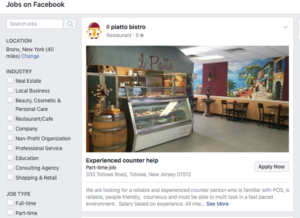
Facebook has actively entered the job board business. They announced this intention on February 15, 2017, in a blog post outlining their offering. It’s currently available in the U.S and Canada for iOS and Android apps as well as the website version. This will be scary news for companies like LinkedIn and Indeed.com who charge companies to list on their sites. It’s now free on Facebook where 1.86 billion users play. Very clever!
It’s super simple for companies’ page admins to create a job post, track applications and communicate directly with applicants via Facebook messenger. There is no limit to the number of posts per page. Businesses have been placing job posts in the past but this feature allows an easier communication process and dedicated space for the job listings. Business pages will now be able to post their job listing directly to the news feed through the status update composer as well as being able to host them on a jobs tab on their own page. If they want to promote a job listing, well they can just pay a little more to reach the right target audience by making the post an ad. A lovely revenue stream for Facebook.
Facebook’s Vice President of business and platform, Andrew Bosworth, said of the new feature, “We’re taking the work out of hiring by enabling job applications directly on Facebook. It’s early days but we’re excited to see how people use this simple tool to get the job they want and for businesses to get the help they need.”
Going Public?

If you’re job hunting you can apply to any of these listings directly through the website or app and continue any discussion with the hiring manager through Facebook messenger. If you see a job post that catches your attention, you just click the “Apply Now” button and your user profile information and picture gets pre-populated and sent along. The company will only be able to access the information that you supply directly and what is “publicly” available for viewing on your current profile. So perhaps it’s time to update your profile pic, change your privacy settings and get rid of those compromising college pics?
Facebook Fishing

This is an inspired move by Facebook – bringing the job market right to where we are already spending loads of time. You might not realize that you are actually looking for a new job until you see an opportunity present itself to you on your favorite social media platform.
Facebook has also created a jobs bookmark to make it easy for users to find and track jobs and you can also see the job posts in your news feed as well. You can imagine that if a friend of yours sees a post that fits your current job search they are going to share it to your page or tag you instantaneously. Now you have your Facebook community helping you to find a new job as well.
LinkedIn Loses Out

Microsoft bought LinkedIn last year and an area they seemed to have ignored is the lower skilled worker and this is where Facebook has moved purposefully into the gap. LinkedIn is ideal for active job seekers who are searching for medium and high-skilled job opportunities with a strong focus on their education and résumé. It is not a platform for part-time or hourly job seekers –but Facebook most certainly is the ideal forum. Facebook reported that 40% of small businesses are having a seriously difficult time filling jobs and this is where they can assist them to get their job post to a wider pool. That audience increases, even more, when there is a Facebook ad spend to put the job in front of even more targeted users. It sounds like a no-brainer.
Face Facts
Facebook asked the question, “How can we make Facebook more useful in your everyday life?” And “entering the job posting market” was the obvious answer. You can see that in a relatively short period of time Facebook will start with relevancy sorting and start matching your education and work experience to the perfect job. You can search directly for the latest job postings at Facebook.com/jobs.
Let Us Help You Face This New Job Board
Even though you’ll be communicating with your future employer on Facebook messenger at some point you’re going to need to send your résumé. Spend quality time crafting a perfect résumé as well as your cleaning up your Facebook profile for maximum impact. Speak with one of our Résumé Experts today by submitting an inquiry here – we would love to hear from you.
Respected Résumés has 20 years’ experience in the field, producing more than 100,000 résumés. We have a 93% success rate in obtaining interviews.
Essential Follow-up Strategies For The Job You Want
You found the perfect job listing. You popped off your perfectly crafted résumé to the hiring manager and you start the waiting game. You dive for your cell phone every time you hear an alert and scroll madly to see if you have had any response to your application. Or maybe you went in for an interview and are now anxiously waiting to hear whether you have been given the job? It’s your dream job, so you are ready to wait for how ever long it takes. But how long is too long? At some point you are going to have to engage in some well thought out follow up email action.
“Things may come to those who wait, but only the things left by those who hustle.” -Abraham Lincoln

Many people avoid this vital step. They don’t want to seem too desperate or too keen. They don’t want to “bug” the hiring manager. They would prefer to just sit it out and wait.
This retiring, wait and see attitude might actually cost you the job. ALWAYS FOLLOW UP! Amy Ashmore, Ph.D. states that “life begins at the end of your comfort zone.” She advocates that highly successful people are those who are “willing to put up with being uncomfortable to get what they want.” So, you’re going to need to start working on your follow-up strategy. You are going to kick into high gear and proactively seek the response you require.
What Are The Appropriate Time-Frames For Sending a Follow-Up Email?

You need to commit to a calendar date for your follow-up strategy – to alleviate your sleepless nights and stall the waiting game!
- Thank you email after the interview: 24 hours
- Checking to see if the hiring manager received your job application: 48 hours
- Waiting for confirmation of a job offer: 1-2 weeks after the interview. However, if the company gives you a specific date for contacting applicants –don’t send a follow-up until after the specified date. (4-5 days after the date they gave)
“Waiting turns men into bears in a barn and women into cats in a sack.” – Robert Jordan
Tone, Tenacity, and Templates
Tenacity is another hallmark of a successful person. These people succeed because they keep their eye on their goals and actively pursue them. They see a follow-up email as an opportunity to tell their potential employees more about themselves and their current achievements. Where does your level of personal daring lie on the follow-up email Richter scale?
Do you favor a traditional tone? You mention you are “just following up” about the job application/interview/position. Short, polite and you’re putting yourself in the hiring manager’s inbox again.
Next level of seismic activity: Work Share -while reaching out and asking what further action they might need from you, use the opportunity to let them know about a success you achieved in your current position and how you look forward to doing the same for their company.
Boost Your Candidacy: Here you do all of the above but perhaps reiterate why you are an ideal match for the job. If there were areas in the interview that you felt you could have improved, use the follow-up to clarify that specific point.
Always be prompt, polite and personal. Always say thank you. Offer context by reminding them who you are, what communication there has been to date and the position you are applying for.
In the communication be sure to never put the hiring manager on the defensive by saying, “Hello, you’ve missed the deadline.” Place no demands, but rather ask if there are any updates on the position or ask if they require further information from you.
In the event that you receive another job offer be sure to timeously inform the company as they might have already chosen you, and have started the process of bringing you onboard. It is common courtesy to follow up with the information and it will stand you in good stead in your industry in the long run.
Many people choose to customize existing templates so they can utilize the right format for the appropriate follow-up email. There are options for every job type with concise content scenarios to assist you with creating an attention-grabbing correspondence.
“And sure enough even waiting will end…if you can just wait long enough.” – William Faulkner
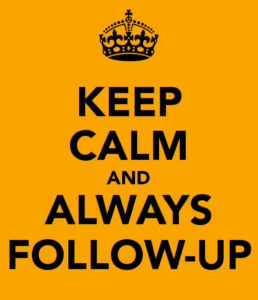
Don’t over analyze why you haven’t heard back from them yet. There is a myriad of reasons for a slower turn around time in the interview process. They could have interviewed a large number of people? Perhaps a key decision maker was on sick leave or vacation? Don’t let your mind wander into negative territory. Keep Calm and Follow Up!
Following up shows your potential employer that you are engaged and interested in the position. You can share your enthusiasm (positivity is infectious) and it will set you apart from the other candidates. It’s a brilliant vehicle to demonstrate your initiative taking prowess.
At the very least a follow-up email can give you closure if you haven’t landed the job so you can then spend your energy on your next effort instead of leaking your vitality to a no action taking, waiting process.
Let Us Show You How

Job hunting doesn’t start and stop with your exceptional résumé. It’s a process with many clear and necessary steps. Let us assist you with your overall job seeking strategy. Speak with one of our Résumé Experts today by submitting an inquiry here – we would love to hear from you.
Respected Résumés has 20 years’ experience in the field, producing more than 100,000 résumés. We have a 93% success rate in obtaining interviews.
“If we wait until we’re ready, we’ll be waiting for the rest of our lives.” – Lemony Snicket
Proven LinkedIn Strategies That Will Get You Results
Job hunting? Let’s state this categorically upfront –your LinkedIn profile is NOT your online résumé! They each fulfill specific functions. You know that LinkedIn is the social media platform that draws recruiters en masse, but are you maximizing the power of your profile? It has to work in tandem with your résumé not replicate it.
LinkedIn now has 3 million active job listings on the platform.
Your future employer is trawling LinkedIn as you read this, vetting potential candidates. Have you got a LinkedIn strategy to stand out from your competition?
Total number of LinkedIn Users (24/01/2017): 467 MILLION!
Of course, elements of your résumé will pop up in your profile but the way your content is presented in the two formats should be completely different.
Vital Questions to Ask Yourself When Creating Your LinkedIn Profile
- Does your Headshot look professional?
- Have you customized your LinkedIn URL?
- Is Your Headline Capitalized?
- Are you using adventurous, eye catching, attention grabbing adjectives?
- Are you rambling?
- Is your content click worthy?
- Are you writing in the 1st Person? (3rd person is a no-no)
- Is there a rousing CTA? (Call to Action)
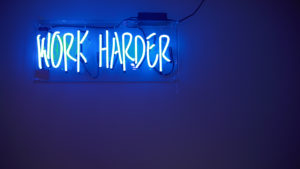
Souped-up Summaries
You have 2000 characters to make a defining personal brand statement. Make every word count.
- The summary answers the questions, “Who do I service” and “How do I assist them.”
- Make a bold opening statement: Only the first 50 characters can be viewed by non contacts. (unless you have an open profile)
- Ensure the summary is keyword-rich
- Are you weaving an enticing story about yourself and your achievements? Your story “should be designed to educate, entertain and illustrate your area of expertise, enticing people to reach out by giving them a taste of who you are and what you do”. Mark Amtower
- Define your professional career goals and how you are currently going about achieving them.
- Highlight the value you will bring to any organization.
- Make sure it is visually interesting to read –use headings, sub heading and visuals
- Try to use 250 words or less.
- Don’t add information about your family, hobbies or favorite pets. Leave that for Facebook.
- Add a “Specialties” section at the end of your summary to include researched keywords that align to your skill set so the right recruiters can actually find you.
- Avoid over used “buzzwords” like creative, expert, passionate and successful.
- Include the most direct way to contact you in your CTA at the end of your summary. (Phone, email, twitter handle etc.)
- Use the formatting rule of 3X3 –three paragraphs in total with three or less sentences in each section. Paragraph 1: Purpose, Paragraph 2: Professional Mission, Paragraph 3: CTA

Strategy for the Specific Sections
- Expand On Your Experience: Your résumé includes relevant and recent employment history whereas LinkedIn gives you space to expand on more of your professional experiences. (Stick to useful experience not ALL of your experience)
- Target employers with your skill set: People who list skills on their profile get 13 times more views. Stating skills gets you noticed. Thoroughly dissect job descriptions in your field and liberally apply those key words to your skills section and highlight how you achieved them.
- Build Endorsements: Kindly ask your connections to generously endorse your skills.
- Pride in your portfolio: Attach some of your best presentations and work successes.
(Check out this awesome LinkedIn Cheat Sheet Infographic.)
Directing More LinkedIn Traffic to Your Profile

- Publishing regular, intellectual, informative posts is the perfect opportunity to show your professional experience and extensive knowledge in your field.
- Actively participate in forums, discussions and groups in your industry
- Place a large amount of effort in growing your network.
- When requesting a connection, make sure you have personalized your message. Its an opportunity to be memorable.
“A huge number of jobs that are filled are never advertised to the public, or if they are, they’re filled with people who have a connection to the employer.”
― Melanie Pinola, LinkedIn In 30 Minutes: How to create a rock-solid LinkedIn profile and build connections that matter
Let Us Show You How
Don’t do a rush job on your LinkedIn Profile. Spend quality time on your résumé as well as your LinkedIn profile so they work hand in hand –reinforcing one another. If writing either of these essential career documents has you covering behind your desk –Respected Résumés can make your life a whole lot easier.
Speak with one of our Résumé Experts today by submitting an inquiry here – we would love to hear from you.
Respected Résumés has 20 years’ experience in the field, producing more than 100,000 résumés. We have a 93% success rate in obtaining interviews.
Crafting Effective Cover Letters
You’ve found your dream job listing and you launch enthusiastically into updating your résumé to talk directly to the job description. You’re energized and are already fantasizing about what your new office is going to look like, but then you are brought down to reality by the looming cover letter ask. “Do people even read them?” you ask yourself. Well, yes they do. “Not sending a cover letter is a sign of laziness” says Jodi Glickman author of “Great on the Job.” But you’re not lazy you are just overwhelmed by the daunting task, right?
So What Is the Aim of the Cover Letter?
“The résumé focuses on you and the past. The cover letter focuses on the employer and the future. Tell the hiring professional what you can do to benefit the organization in the future.” – Joyce Lain Kennedy, Cover Letters for Dummies
It’s a one-page call to action inspiring a potential employer to read your attached résumé. You will introduce yourself -not your entire biographical memoir just the highlights that pertain to the job offered. You’ll make a clear case as to why you are the perfect fit for the job. You’ll add elements that your résumé doesn’t capture and perhaps expand on some aspects of your résumé that needs context or fleshing out. It’s a request to meet the employer in person. In one page! This is the best friend to your brilliantly written résumé – it’s going to speak on your behalf, talking up your great qualities. This is you making a good first impression –because it counts. When a cover letter is written well it instantaneously tells your employer about your level of communication skills.
One-Page Format to Follow
“The most valuable of all talents is that of never using two words when one will do.” – Thomas Jefferson
∞ Clear Contact Info: Add both the employers and you own information.
∞ Personalized Introduction: find out the name of the hiring manager. Don’t “Sir or Madame” anyone it’s the 21st century, also run a mile from “To whom it may concern.”
∞ Paragraph 1: Mention the position you are applying for and where you found the listing. Succinctly highlight basic info about yourself like your degree and expertise as well as how your career goals align with their company’s vision.
∞ Paragraph 2: Put your best foot forward. Sell how your skills match the company’s need using actual phrases from their listed job description.
∞ Conclusion: Bold CTA (call to action) about why they should interview you immediately.
Style tips: use 1” – 1.5” margins, font size must be 12 point and above, match font style to the employers one used on their website (or one that is synonymous with professional documents), keep paragraphs left aligned (i.e. uniform alignment throughout). Organize each paragraph around a clear main point in a logical sequence.
Here Are Some Crucial Do’s and Don’ts
DO…
∞ Research: Look up the company. Find out everything about them. Reading the job description is not enough. When you know their company culture it will guide your use of the right tone for your cover letter.
∞ Tailor Make: Ensure your letter demonstrates knowledge of the company you are applying to and isn’t just a cut and paste template.
∞ Attract Attention: Start strong showing your personality.
∞ Highlight your Personal Value: Show how you can solve problems facing the company and show how your experience matches their needs.
∞ Be Authentic: Convey your enthusiasm in a mature and professional way.
∞ Keep it Short: Less is more. It must be able to be read at a glance. 250 words are actually ideal.
∞ Show Future Fitness: Explain how you will work on the key business challenges going forward. “This is what I can deliver…”
∞ Show Skills: Highlight skills over education
∞ Add Figures: Employers love to see the numbers. Don’t be scared of showing the stats of your skills.
∞ Get Advice: Ask a friend to look it over to test its efficacy.
DON’T…
∞ Use Jargon: Avoid long sentences.
∞ Hard Sell: and steer away from gimmicks.
∞ Try to be Funny: It usually falls flat.
∞ Flatter Unnecessarily: You’re not a teen fan.
∞ Use Generics: Customize for every job.
∞ Repeat your Résumé: describe additional details
∞ Use bullet points: Full sentences are required.
∞ Talk about yourself only: It must be in the context of how you can serve the job not the other way around.
∞ Apologize: Don’t draw attention to your weaknesses or lack of skill in a certain area by apologizing.
∞ Use too many adverbs: Be normal.
Don’t’ Forget to ATS Format
“There is a way to do it better…find it.” – Thomas Edison
ATS or Applicant Tracking System is the automated software that reads through résumés and picks out key phrases and words to statistically decide whether you get to go to the next round. Apparently, almost 70% of all jobs are filled using ATS. There are some ATS software capabilities that also reads through cover letters as well. While not all of them do, it is worth it to make all aspects of your correspondence to be ATS compliant. This translates into making sure you have included the words from the actual job description into your cover letter to improve your chance.
Not Sure Where to Start?
“No one ever gets very far unless he accomplishes the impossible at least once a day.” -Elbert Hubbard
Speak with one of our Résumé Experts today by submitting an inquiry here– we would love to hear from you.
Respected Résumés has 20 years’ experience in the field, producing more than 100,000 résumés. We have a 93% success rate in obtaining interviews, and that is precisely the sort of advantage you need on your side. Let’s get to work!
Résumés Versus CVs – When to Use Which
You are job hunting, and you want to make sure you are utilizing the most appropriate formats for introducing your skills and experience to a potential employee. The choice of sending either a résumé or curriculum vitae (CV) often comes down to the geographic location of your potential employer. In the United States, the résumé is the most commonly used vehicle to apply for jobs. A CV is usually only sent in the US for academics and medical professionals seeking positions.
Outside of the U.S., full curriculum vitae is expected when you apply for work –specifically in the Middle East, New Zealand, U.K., Ireland, Asia and Africa. For Australia, you will have to apply using both résumé and CV. You will also use a CV if you apply for international fellowships or grants as well as for research positions. So now you know which country requires which format but are you up to speed on what constitutes a great résumé or CV?
It is crucial to understand that a résumé is not just a shortened version of your work experience and a CV is not the receptacle for everything and the kitchen sink. Both formats have very distinctive functions, and it is essential to be able to know how to build each one systematically.
“I’m a great believer in luck, and I find the harder I work, the more I have of it.” – Thomas Jefferson
The Résumé Recipe
First up: The résumé structure and purpose:
It’s a punchy, general, concise introduction to your skills and experience. This must relate to the specific position you are applying for, so your résumé is relevant to the work offered. You will need to adjust your résumé for different positions so you can emphasize certain skills or work experiences that speak to the employer’s requirements. You do not have to order your résumé chronologically; you must tailor make and customize the document for every different job application. It can be time-consuming, but you will benefit greatly from this additional effort. The essential information is your name and Contact Information, Education and Work Experience. N.B.: Only one page in length! You must do your best to stand out in this short format truly. Aim to be memorable. A cover letter is usually expected as an accompaniment to the résumé. This is the permanent written record that your résumé was indeed sent and to whom it was delivered.
“Success doesn’t come to you; you go to it.” – Marva Collins
The CV Story
Curriculum vitae format and function:
A CV is longer –by at least 2-3 pages for someone at the start of their career, and for seasoned professionals, this could run into double digits. It’s a pretty detailed overview of all of your significant accomplishments to date so it could get very long. The information in the various sections should always be organized chronologically. Obviously, a CV will need to be updated fairly regularly as your achievements grow annually but you won’t be changing the structure when applying for different jobs –that will stay static.
You can imagine how long these documents can be when you think of people who have careers in academia and research who are always publishing and working on a broad range of projects simultaneously. Along with the fields in the résumé format, a CV will also include Areas of Interest, Grants, Honors and Awards, Publications and Presentations, Scholarly or Professional Membership and References. A curriculum vitae summary is usually attached, this condensed version is anywhere from 1-2 pages depending on the length of the entire CV document. This allows the potential employer to get a solid overview of the candidate before tackling the minutiae of their life achievements. This could also be requested if there is a large pool of applicants for a particular position.
“Big jobs usually go to the men who prove their ability to outgrow small ones.” – Ralph Waldo Emerson
Side By Side Recap Resource
Here is a quick comparison chart of the differences between the two formats:
| Résumé | CV |
| Short -1-page ideal. No more than 2 pages | Long |
| No particular format rule | Covers your entire career |
| Highly customizable | Static |
| Selective | Comprehensive |
| Emphasize skills | Highlights academic achievements |
| Used for positions in public sector, non-profit or industry | Used for applying for openings in academia, medicine, fellowships, and grants. (or abroad) |
| Once you have been working for at least one year lead with work experience and place education near the end. (depending on qualifications) | You will always start with education. Include advisors name and dissertation title or summary |
The Devil is in the Detail
A few tips and tricks for both CV and résumé writing:
- Match your work experience and skills to the position or industry you wish to enter. E.g. put the most relevant work experience for the job advertised at the top of your list.
- Include keywords from the posted job description into your CV or résumé to be in alignment with the applicant tracking software (ATS) that pre-sorts applicants.
- Use a template to optimize the structure of your document and ensure you have covered all of the categories.
- Edit and proofread to ensure there are no typos, spelling or grammar errors. Keep your format uniform.
“Whenever you are asked if you can do a job, tell ’em, ‘Certainly I can!’ Then get busy and find out how to do it.” – Theodore Roosevelt
Overwhelmed? Need Some Assistance?
We would love to hear from you. Click the link below if you would like to learn more.
Click To Speak With A Résumé Expert Today
Respected Résumés has 20 years’ experience in the field, producing more than 100,000 résumés. We have a 93% success rate in obtaining interviews, and that is precisely the sort of advantage you need on your side. Let’s get to work!
“Never tell me the sky’s the limit when there are footprints on the moon.” Author Unknown
Bypassing the ATS System (Résumé Robots)
Applicant Tracking Software is flawed
Applicant Tracking System (ATS) programs have been with us for a while now. They were first introduced just before the turn of the century with names like BrassRing and RecruitMax. Being almost 20 years old you might think they were a mature technology that was sophisticated, predictable, and easy to understand. Unfortunately, as Paul Reiser would say, “Not so much.”
Here’s the problem as it exists now. All applicant tracking systems use the same word-parsing parameters, with only minor variations. Natural Language (NL) processing and Artificial Intelligence (AI) have both evolved tremendously in the last 20 years, but the parsers are still stumbling over themselves and each other.
Succeeding Where Others Fail
When you create a résumé, always use a traditional .txt, .doc, .docx or other conventional format. ATS software is notoriously bad at interpreting .pdf files. They cannot cope—they get confused—and your résumé will almost certainly be parsed incorrectly. At that point it will be rejected as being “unqualified” because it cannot pull out the facts it needs.
Millions of well-qualified candidates are rejected because they don’t conform to parsing expectations. So why do we keep using this system? First of all, it’s getting better, albeit slowly. Second, it takes a stack of résumés (potentially hundreds for each position) and turns it into the top 10 choices for a human being to look at.
Of course, they will lose great candidates. That is just the price they are willing to pay so that you don’t have to review so many documents. And despite the losses, they still get decent choices and a good place to start.
“There are no secrets to success. It is the result of preparation, hard work, and learning from failure” — Colin Powell
Keep in mind that parsing programs are still pretty dumb. Only include graphics or tables if you want your résumé to be rejected.
Here’s the problem: ATS software can’t assess pictures, and it reads tables from top-to-bottom, not left-to-right. The first column in your table might be a list of names, while the second might be a list of dates; what happens is that two facts which would be visually related when a human looks at it, fails to make any sense to the software. So just don’t do it.
Parsers Look at Things Differently
An original job description might look like the image below. The ATS software will go through it and select unique phrases (in red here) which differentiate it from all other positions being offered. Then a human may go in and add some specific terms that they desire.
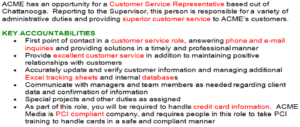
Acronyms are Cool
Like the example above, if they are looking for a “Customer Service Representative” then use that term, but also include CSR because that may count towards your final score.
When ATS scans a résumé it will score the number of times you use these unique phrases from the original description. How many times have I seen a programming position advertised and then résumés come in laden with terms like “coder” or “code-wizard”, but not even once using just plain “programmer“?
“Error-prone applicant tracking systems kill 75 percent of job seekers’ chances of landing an interview as soon as they submit their résumés, despite how qualified they may be” – Meridith Levinson
You’re not “security conscious” or “threat-aware“; you’re PCI compliant, so say so. Whatever you see in the original offering, feed it right back to them. It’s not just a good idea—it’s the fundamental basis upon which the system operates.
Your goal is to get past these parsers, so you must follow their rules. One of the most important ones is to use the expected phraseology. Write “Work Experience“, not “Career Achievements” or “Professional Skills” because ATS Software will not recognize your creative terms. Use “Education“, “Skills“, and “Contact Information“. Your artistic choices may sound nicer, but it also means you won’t get hired.
Size isn’t Important
You hear it over and over again: Keep it brief. That would be an excellent idea that is both courteous and respectful of the reviewer’s time. But humans don’t see your résumé until well after they have decided to put your name on the interview list.
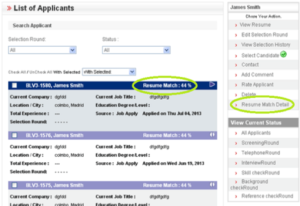
They have an excerpt that the ATS has collected and put into a database. What they will look at is similar to this image, where they can see how well you match the job description, and then elect to add you to the interview pool.
Other Stuff
Conformity is important. When you get around to writing down your Experience make sure it is always formatted Employer’s name, Job title, and then Dates of employment. If you start with a date the entire line will be ignored. That means a vital statistic, your experience, will not be included. And that will get your résumé kicked out of the system because you are “unqualified.”
The Takeaway
Properly constructed, your résumé should just fly through the system, landing right on top of the stack of interviewees. Take the time to learn to do it right to satisfy machines and please humans and you’ll have plenty of interviews.
Want to Know More?
We would love to hear from you. Click the link below if you would like to learn more.
Click To Speak With A Résumé Expert Today
Respected Résumés has 20 years’ experience in the field, producing more than 100,000 résumés. We have a 93% success rate in obtaining interviews, and that is precisely the sort of advantage you need on your side. Let’s get to work!
